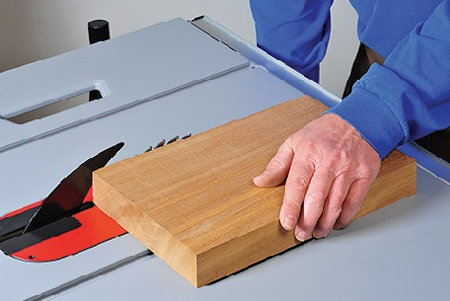Page Contents
How High Should I Set my Table Saw Blade?
There are 2 possible answers. The blade should barely come above the wood you are cutting, or the blade should be well above the wood you are cutting. The answer isn’t obvious as there are pros and cons to each method. But in the end, I hope you see that one way is superior to the other.
The Safest Cut

It’s my opinion that the best cut is the safest cut. I don’t want to lose a finger when I could have gotten away with a few stitches or a band-aid. With that in mind, the safest height to set a table saw blade is so it’s just above the wood you are cutting.
The general rule of thumb is that the blade should be set so it is 1/8” above the workpiece. If you make contact with the blade with your hand at this height, you’re unlikely to lose a finger. That’s enough reason for me to be on the barely above the wood side of this question.
The Manufacturers Recommendation

A more technical answer that comes from the blade manufacturers themselves is that you should have 3-5 teeth into the wood when you’re ripping, and 5-7 teeth into the wood when you’re making crosscuts or cutting anything that’s not 100% organic wood from a tree (laminates, veneers, MDF, metal, etc.).
Using those recommendations, you would set your blade so it’s barely above the workpiece. That is generally going to be around 1/8” above the top of the workpiece.
Blade manufacturer Freud recommends that you have ½ of one tooth above the wood. Taking their recommendation, you will have 3-5 teeth into the wood when ripping, and 5-7 teeth into the wood when crosscutting. If you can’t maintain that ratio, then you might be using the wrong saw blade for the cut.
Setting The Blade Higher
The argument made for setting the blade higher is a valid one. There is less strain on the table saw motor. The motor is working more efficiently because there is less of the saw blade cutting into the wood at one time. There is also less heat generated by the blade, and there is less resistance while making the cut . The teeth also come down at a steeper angle and that leads to better cutting action but sometimes leads to more chip out to the top face of the workpiece.
When cutting thin materials, like ¼” thick veneer, you will finish with a better-looking cut with the table saw blade set higher vs. setting it at 3/8”. The same goes for cutting a very thin piece workpiece. It can be beneficial to set the blade a little higher to get the better cut in these cases.
However, if I’m constantly getting better results from having the blade set very high, I think I would need to look at either the quality of the blade, the accuracy of the saw set-up, or whether I’m using the wrong blade for the wrong purpose.
